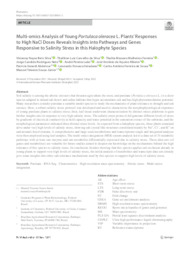Multi-omics analysis of young Portulaca Oleracea L. plants' responses to High NaCl doses reveals insights into pathways and genes responsive to salinity stress in this halophyte species.
Multi-omics analysis of young Portulaca Oleracea L. plants' responses to High NaCl doses reveals insights into pathways and genes responsive to salinity stress in this halophyte species.
Autoria: SILVA, V. N. B.; SILVA, T. L. C. da; FERREIRA, T. M. M.; RODRIGUES NETO, J. C.; LEAO, A. P.; RIBEIRO, J. A. de A.; ABDELNUR, P. V.; VALADARES, L. F.; SOUSA, C. A. F. de; SOUZA JUNIOR, M. T.
Resumo: Soil salinity is among the abiotic stressors that threaten agriculture the most, and purslane (Portulaca oleracea L.) is a dicot species adapted to inland salt desert and saline habitats that hyper accumulates salt and has high phytoremediation potential. Many researchers consider purslane a suitable model species to study the mechanisms of plant tolerance to drought and salt stresses. Here, a robust salinity stress protocol was developed and used to characterize the morphophysiological responses of young purslane plants to salinity stress; then, leaf tissue underwent characterization by distinct omics platforms to gain further insights into its response to very high salinity stress.
Ano de publicação: 2022
Tipo de publicação: Artigo de periódico
Unidade: Embrapa Agroenergia
Palavras-chave: Espectrometria de massa de alta resolução, Estresse abiótico, Quimiometria, RNA-Seq
Observações
1 - Por padrão são exibidas publicações dos últimos 20 anos. Para encontrar publicações mais antigas, configure o filtro ano de publicação, colocando o ano a partir do qual você deseja encontrar publicações. O filtro está na coluna da esquerda na busca acima.
2 - Para ler algumas publicações da Embrapa (apenas as que estão em formato ePub), é necessário ter, no celular ou computador, um desses softwares gratuitos. Sistemas Android: Google Play Livros; IOS: iBooks; Windows e Linux: software Calibre.
Acesse outras publicações
Acesse a Base de Dados da Pesquisa Agropecuária (BDPA) para consultar o acervo completo das bibliotecas da Embrapa.

